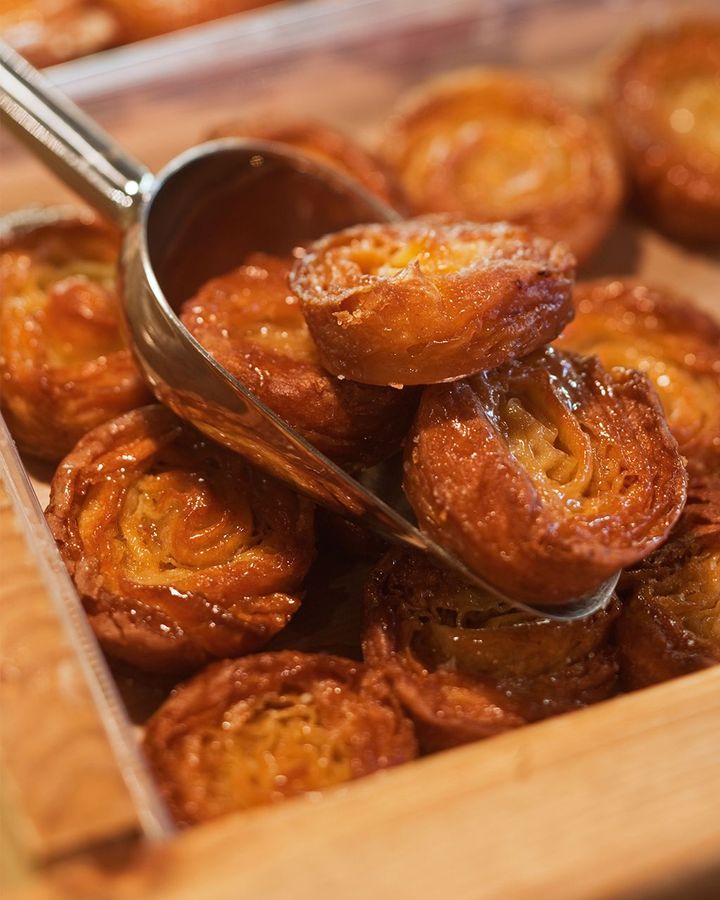A small group of French pastry chefs aim to preserve the quality and techniques used to make the buttery, flaky and indulgent pastry from Brittany.
O
On a Sunday morning in the French coastal town of Douarnenez, a queue snakes out the door of a boulangerie. This is a common enough sight across the country, where picking up freshly made bread is a daily ritual, but here the people aren’t just buying a baguette. Most are also waiting to purchase one of the kouign-amann, dubbed ‘the fattiest pastry in Europe’, which sit in stacks behind the counter, their laminated pastry glinting as they’re picked up and slipped into a greaseproof paper bag.
Eaten warm, the cakes are an exercise in indulgence. The chewy, caramelised crust yields to expose the flaky pastry of the interior, bursting with a rich, buttery flavour. Translated from the Breton language, kouign-amann literally means ‘butter cake’, which is appropriate, because of the six ingredients in the traditional recipe, butter features in the highest quantity.
Kouign-amann are an institution in Douarnenez, a traditional fishing town situated in the west of France’s Brittany region, having been invented there some 160 years ago. The pastry was born out of necessity when the baker, Yves René Scordia, who owned a shop in the town, needed to replenish his stock in a hurry after selling out of cakes. Finding he had bread dough, butter and sugar, he combined the ingredients with the folding technique used for puff pastry, and the result was the kouign-amann.
The cake quickly became popular across Brittany and was soon known throughout France. However, it was often attributed to larger cities in Brittany like Vannes, Saint-Malo or La Rochelle, and, as it eventually began to be produced on an industrial scale and by bakers who approximated or altered the recipe, bakers from Douarnenez making it in the traditional way felt that it had begun to stray from the quality of the original.
For this reason, in November 1999, 17 pastry chefs and bakers came together with a shared passion for their town’s speciality to form the Association of the Kouign-Amann of Douarnenez, with the aim of promoting the cake and preserving its quality and the techniques used to make it.
Pascal Jaïn, boulanger, pâtissier and chocolatier, is a member of the association and produces kouign-amann at his bakery, Boulangerie Jaïn, in Douarnenez. For him, the cake is defined by the skill of those baking it.
“What makes the kouign-amann so special is its making, which is very simple – bread dough, butter and sugar – but it all relies on the technique,” said Jaïn. “All the members of the association use the same ingredients. The quantities may vary but not that much. The most important thing is the method. In my bakery, we have three people making kouign-amann and we can tell who made each one as they come out of the oven.”
Traditionally, the cakes feature no additional flavouring and are made to serve multiple slices, but smaller, individual cakes called kouignettes have become increasingly popular, as have flavoured versions. Jaïn embraces these changes but is keen to ensure that the original version doesn’t disappear.
Individual cakes called kouignettes have become increasingly popular (Credit: Hemis/Alamy)
“You can find kouign-amann in all corners of Brittany, but for us, it is another product, not the one we defend,” said Jaïn. “We are not saying that ours is better, but that it’s made with the original technique [with each cake made individually by hand using traditional bread dough and without any added flavourings or garnishes], that it is the authentic end product, and that it deserves to be tasted. We want the way it is made in Douarnenez to survive.”
Kouign-amann have become much more than just a regional speciality. Over the last decade or so, the cake has been making waves in bakeries across the US and has also found popularity in Japan and Singapore.
Belinda Leong, renowned pastry chef and owner of bpatisserie in San Francisco, discovered the kouign-amann while interning at a bakery in New York. “When I saw it, I was intrigued by the look, the texture, the flavour, and how I had never seen a pastry like this before. I wanted to immediately find out how to make it and learn about it,” she said.
Leong took the idea of the cake with her after her internship and spent years making kouign-amann for VIPs at the Restaurant Gary Danko in San Francisco, eventually bringing it to bpatisserie, where it’s now an established speciality produced in classic, seasonal fruit and chocolate varieties. Despite being less familiar than other French patisseries, Leong explained it’s a hit with the locals. “It’s hugely popular. Many people ask about it and how to pronounce it, there are 50 ways to say kouign-amann [and] I’ve heard many of them.”
Thrina Low, owner of Brera Bakery in Singapore, wasn’t sure if the idea to start making kouign-amann came from her team or if it was requested by French expatriates, but it’s since stuck as a staple of the bakery due to its popularity with her customers. She explained, “Once they try it, they get hooked and keep coming back for more. It’s been a sell-out item every day.” Low has also experimented with different flavours, including cinnamon and fresh pineapple with cream, and she is currently working on a cardamon version.
Both bpatisserie and Brera Bakery reported that their traditional, unflavoured varieties of the kouign-amann are their bestselling versions. Even divided by thousands of miles, the tastes of the people have confirmed the principles of the bakers of Douarnenez, that simple is best, and it’s the skill of the baking that makes the kouign-amann stand out.




